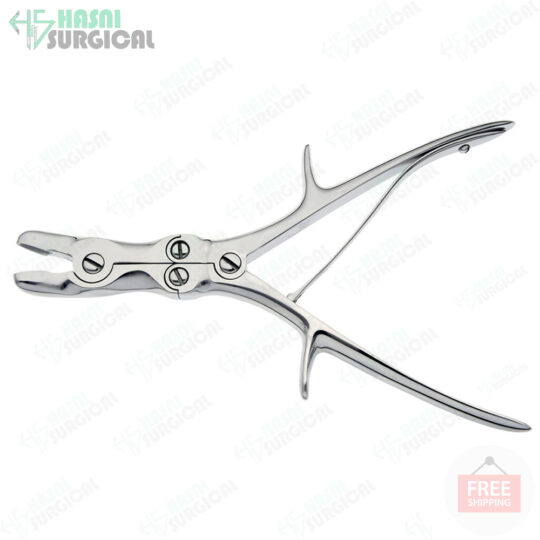Description
Orthopedic Angled Bone Saw: A Precision Tool for Orthopedic Procedures
An angled bone saw is a specialized surgical instrument designed to cut through bone with precision and ease. It is commonly used in orthopedic surgeries, particularly during procedures that involve bone fractures or the need to remove or reshape bone tissue. This tool ensures that the bone is cut in a controlled and accurate manner, minimizing any potential damage to surrounding tissues. A key feature of the angled bone saw is its ability to cut through hard materials, such as bones encased in plaster casts, during the healing process following fractures.
Key Features and Design of the Angled Bone Saw
The angled bone saw typically has a length of 6 inches (15.24 cm), making it compact enough to handle with precision while still offering ample cutting length for a wide range of procedures. Its sharp, half-circle blade is designed to make clean cuts through both bone and plaster with minimal effort. The blade is removable, which makes it easy to clean, sterilize, or replace when necessary.
The saw’s design features a large loop handle with a thumb rest grip, providing the surgeon with a comfortable and secure hold. The ergonomic handle allows for greater control and accuracy during use, which is crucial when working in delicate surgical areas. The loop design also facilitates precise movements along the plaster or bone, ensuring that the saw operates effectively in tight or challenging spaces.
Materials and Durability
Made from high-quality stainless steel, the angled bone saw is designed for durability and long-lasting performance. Stainless steel is renowned for its strength, resistance to corrosion, and ability to retain its sharpness even after repeated use. These characteristics ensure that the angled bone saw remains in excellent working condition throughout many surgical procedures, providing the reliability and dependability that medical professionals expect.
Unlike other materials, stainless steel will not bend, tarnish, or lose its edge over time, making the angled bone saw a cost-effective tool in the long run. It meets international quality standards, ensuring that healthcare providers have access to a product that adheres to rigorous medical-grade specifications. Its construction ensures that it can withstand the physical demands of various surgical environments, offering consistent performance across different types of procedures.
Versatility in Orthopedic Procedures
The angled bone saw is widely used in a variety of orthopedic procedures, especially those involving bone fractures and reconstruction. Some of the most common surgeries that benefit from this tool include hip and knee replacement surgeries, spinal surgeries (both neck and back), and surgeries on smaller joints such as the hand, wrist, elbow, and shoulder.
In procedures such as hip and knee replacements, the bone saw is used to carefully remove damaged or diseased bone, allowing for the implantation of prosthetic joints. For spinal surgeries, the saw is instrumental in accessing and preparing the bones of the spine for fusion or other corrective procedures. Additionally, for joint surgeries, such as those involving the hand and elbow, the angled bone saw allows surgeons to perform precise cuts that enable effective repair or reshaping of bones.
Another important application is in the removal of plaster casts around broken bones. The angled bone saw is particularly effective for this purpose, as it can easily cut through the hard, durable layers of plaster that encase a fractured bone. The tool’s sharp teeth and ergonomic handle allow the surgeon to make clean and controlled cuts without disturbing the fracture site, ensuring that the bone is properly supported as it heals.
Advantages of the Angled Bone Saw
One of the major advantages of the angled bone saw is its precision. The half-circle blade ensures that cuts are made at the desired angle, reducing the risk of accidental injury to surrounding tissues. Furthermore, the high-quality construction of the saw ensures it remains durable, even in high-demand surgical environments where repeated use is common.
Another benefit is the saw’s reusability. Because it is made from high-quality stainless steel, it can be reused multiple times without losing its effectiveness. Surgeons can confidently rely on this tool for various surgical procedures, knowing it will maintain its sharpness and performance over time.
Conclusion
In conclusion, the angled bone saw is an indispensable tool in modern orthopedic surgery. Its sharp, half-circle blade and ergonomic handle design make it ideal for cutting through bone and plaster during procedures that require precision and reliability. Constructed from durable stainless steel, this instrument can withstand the rigors of frequent use without compromising its functionality. Whether used in bone fracture repair, joint replacement surgeries, or spinal procedures, the angled bone saw provides healthcare professionals with the accuracy and control needed to perform successful operations and achieve optimal patient outcomes.









































Reviews
There are no reviews yet.